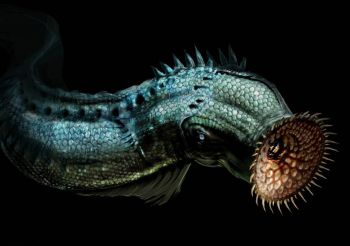Difference between revisions of "Lamprey"
Tao alexis (talk | contribs) |
Tao alexis (talk | contribs) |
||
| Line 1: | Line 1: | ||
{| class="wikitable" style="float:right; margin-left: 15px; text-align: center; background-color:#d4f2f2;" | {| class="wikitable" style="float:right; margin-left: 15px; text-align: center; background-color:#d4f2f2;" | ||
|- | |- | ||
| − | | '''Type''' || '''Lamprey''' || '''Giant Lamprey''' | + | | '''Type''' || '''Lamprey (common)''' || '''Giant Lamprey''' |
|- | |- | ||
| '''Species''' || colspan="2"|[[Jawless Fish|jawless fish]] | | '''Species''' || colspan="2"|[[Jawless Fish|jawless fish]] | ||
| Line 36: | Line 36: | ||
|} | |} | ||
| − | Lampreys are | + | '''Lampreys''' are ancient creatures that are characterized by a toothed, funnel-like sucking mouth. They inhabit both fresh and salt water bodies of water, where they prey upon other fish in order to attach themselves and suck their blood. Occasionally, land mammals and humanoids fall prey to these creatures. The '''common lamprey''' migrates from saltwater to freshwater in order to breed, while the '''giant lamprey''' breeds in intertidal pools. When the giant lamprey's larvae emerge from their eggs, these pools can become extremely dangerous, with 40-100 common lamprey-sized creatures ravenous for food. |
| − | + | ||
| − | + | [[File:Lamprey.jpg|left|350px]] | |
| − | + | Any hit by a lamprey that causes 2 points of [[Damage (hit points)|damage]] indicates the creature has successfully attached itself. Thereafter, until it is killed or made helpless, the '''blood drain''' that follows will enable to the lamprey to automatically cause damage, according to its size. A common lamprey would drain 1-2 [[Hit Points|hit points]] per [[Combat Round|round]], while the giant lamprey would cause 1-6. | |
| − | + | ||
| − | |||
See [[Bestiary]] | See [[Bestiary]] | ||
| − | |||
| − | |||
Revision as of 19:08, 25 August 2020
| Type | Lamprey (common) | Giant Lamprey |
| Species | jawless fish | |
| No. Appearing | 5-20 | 1-4 |
| Behaviour | solitary | |
| Range | intertidal, limnetic | coral reefs, intertidal |
| Size | 25 in. long | 6 ft. 2 in. long |
| Weight | 9 lbs. | 240 lbs. |
| Intelligence | 0 | 0 |
| Armour Class | 9 | 8 |
| Hit Dice | 1 | 3 |
| Action Points | 2 | 3 |
| Max. Stride | 2 | 2 |
| THAC0 | 20 | 18 |
| Hp/Die | d2 | d8 |
| Attack Form | bite | |
| Damage | 1-2 | 1-6 |
| Special Attack | blood drain | |
Lampreys are ancient creatures that are characterized by a toothed, funnel-like sucking mouth. They inhabit both fresh and salt water bodies of water, where they prey upon other fish in order to attach themselves and suck their blood. Occasionally, land mammals and humanoids fall prey to these creatures. The common lamprey migrates from saltwater to freshwater in order to breed, while the giant lamprey breeds in intertidal pools. When the giant lamprey's larvae emerge from their eggs, these pools can become extremely dangerous, with 40-100 common lamprey-sized creatures ravenous for food.
Any hit by a lamprey that causes 2 points of damage indicates the creature has successfully attached itself. Thereafter, until it is killed or made helpless, the blood drain that follows will enable to the lamprey to automatically cause damage, according to its size. A common lamprey would drain 1-2 hit points per round, while the giant lamprey would cause 1-6.
See Bestiary
